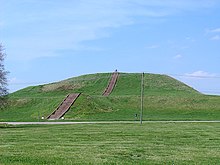
Back Mound Builders Afrikaans بناة الروابي Arabic Higlbaua (Voik) BAR Cultura dels monticles Catalan Moundbuilders German Montetuloj Esperanto Culturas de los constructores de montículos Spanish Muino egileak Basque پشتهسازان Persian Pohjois-Amerikan kummunrakentajat Finnish

Many pre-Columbian cultures in North America were collectively termed "Mound Builders", but the term has no formal meaning. It does not refer to specific people or archaeological culture but refers to the characteristic mound earthworks that indigenous peoples erected for an extended period of more than 5,000 years. The "Mound Builder" cultures span the period of roughly 3500 BCE (the construction of Watson Brake) to the 16th century CE, including the Archaic period (Horr's Island), Woodland period (Caloosahatchee, Adena and Hopewell cultures), and Mississippian period. Geographically, the cultures were present in the region of the Great Lakes, the Ohio River Valley, Florida, and the Mississippi River Valley and its tributary waters.[1]
The first mound building was an early marker of political and social complexity among the cultures in the Eastern United States. Watson Brake in Louisiana, constructed about 3500 BCE during the Middle Archaic period, is the oldest known and dated mound complex in North America. It is one of 11 mound complexes from this period found in the Lower Mississippi Valley.[2] These cultures generally had developed hierarchical societies that had an elite. These commanded hundreds or even thousands of workers to dig up tons of earth with the hand tools available, move the soil long distances, and finally, workers to create the shape with layers of soil as directed by the builders. However early mounds found in Louisiana preceded such cultures and were products of hunter-gatherer cultures.
From about 800 CE, the mound-building cultures were dominated by the Mississippian culture, a large archaeological horizon, whose youngest descendants, the Plaquemine culture and the Fort Ancient culture, were still active at the time of European contact in the 16th century. One tribe of the Fort Ancient culture has been identified as the Mosopelea, presumably of southeast Ohio, who spoke an Ohio Valley Siouan language. The bearers of the Plaquemine culture were presumably speakers of the Natchez language isolate. The first written description of these cultures were made by members of Spanish explorer Hernando de Soto's expedition, between 1540 and 1542.
- ^ Squier p. 1
- ^ Robert W. Preucel, Stephen A. Mrozowski, Contemporary Archaeology in Theory: The New Pragmatism, John Wiley & Sons, 2010, p. 177
© MMXXIII Rich X Search. We shall prevail. All rights reserved. Rich X Search